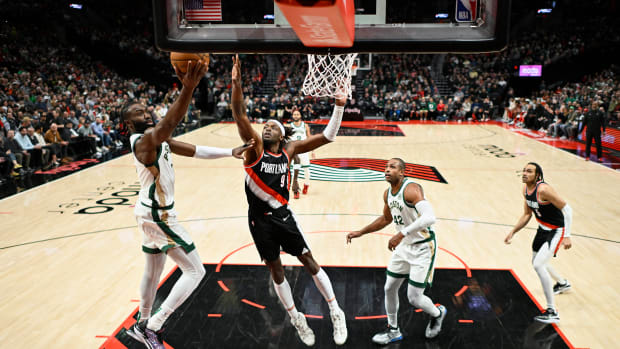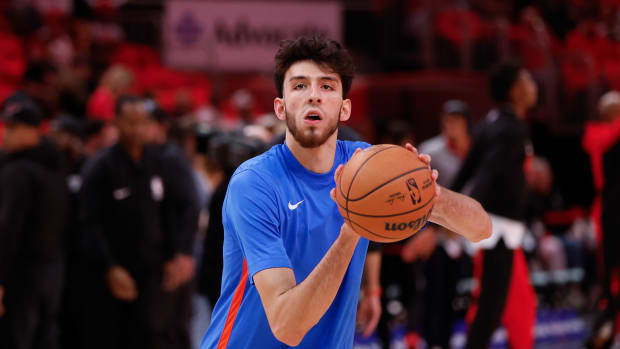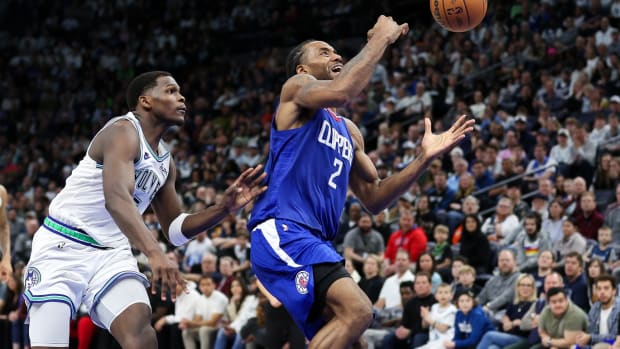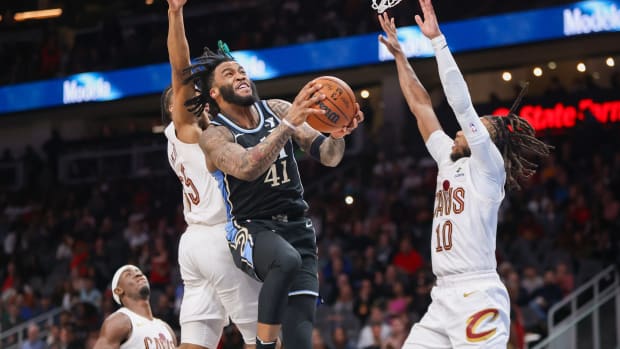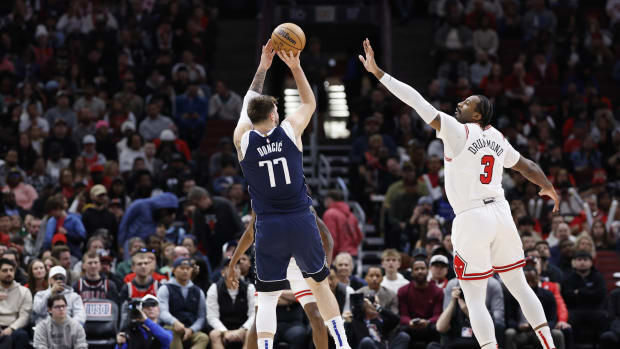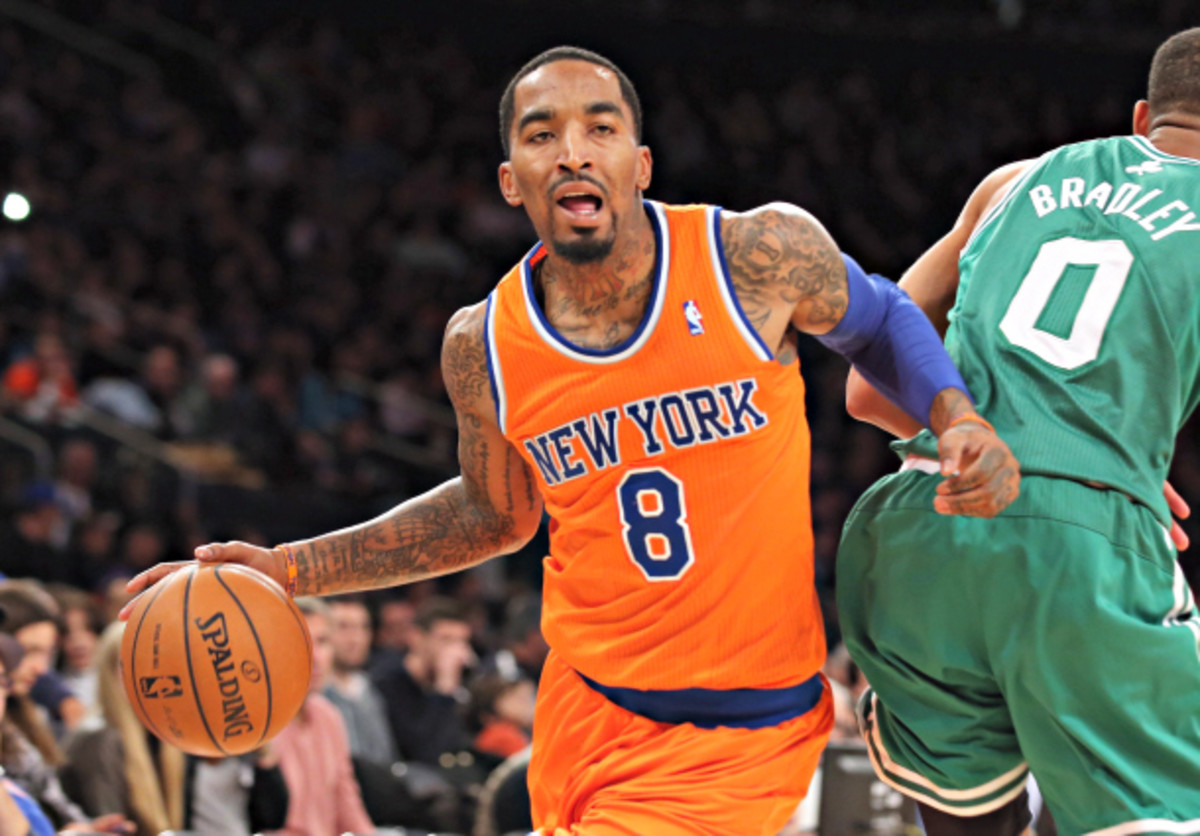
Alternative first-quarter awards: Least Valuable Player, Most Generous and more
J.R. Smith has been brutally inefficient for the Knicks this season. (Bruce Bennett/Getty Images)
With the first quarter of the NBA season in the books, The Point Forward's Ben Golliver doled out hardware and examined the races for official regular-season awards. I, instead, opted to partake in the long-existing Internet practice of handing out entirely made-up awards. Feel free to applaud politely for the winners and dispute away in the comments. (All stats are through Wednesday, Dec. 11.)
Least Valuable Player
J.R. Smith, New York Knicks
An albatross in orange and blue. The league is stocked with players who haven't contributed much this season, but none have been as actively destructive as Smith. Of all the players to average at least 10 shots per game, Smith's 34.4 percent shooting is the lowest. His ambition off the dribble also makes for brilliant slapstick; only a precious few are so committed to driving and spinning into traffic, which in Smith's case so often ends with arms flailed toward the rafters as the ball skitters away.
As a result, Smith's turnover rate has returned to its most problematic levels, all while his shot falls errant and his interest in exerting effort on defense wanes. Smith, at his best, is still essentially a specialist. He helps create offense when actions jam up, offering some slice of redemption to an uneven offense. New York made the most of that ability a season ago, but this season it's gone to the same well only to draw blood. Take a gander at Smith's shot chart: His Red Death has devastated Knicks Country. No pestilence had ever been so fatal, or so hideous.
By and large, though, coach Mike Woodson has remained a Smith advocate, giving more than 30 minutes a game to the impulsive and implosive shooter without regard for Smith's blunders. He is apparently beyond reproach despite a career-low Player Efficiency Rating of 9.0, and for that New York pays the price.
Best High-Usage Lineup
Indiana's starting five of Paul George, Roy Hibbert, David West, George Hill, and Lance Stephenson (Net rating: plus-15.5 points per 100 possessions)
It should surprise exactly no one that Indiana's starting lineup -- which in varied forms has been one of the league's best for years -- has been the top high-usage unit in the league this season. That group defends better than any in the NBA, drawing not only on Hibbert and George as anchors but also leaning on the sturdy coverage of Hill and West and the aggressive hounding of Stephenson. Those five Pacers manage to contain just about everything -- drives, pick-and-rolls, post-ups, the works. Offensively, George's rise as a shot-maker has done wonders for an already balanced group and established even more operating room for Hibbert and West.
In all, they bring a combination of size, talent and effort that overwhelms most opponents. The tone for the best team of this regular season is set at opening tip.
Worst High-Usage Lineup
Oklahoma City's starting five of Kevin Durant, Russell Westbrook, Serge Ibaka, Thabo Sefolosha and Kendrick Perkins (Net rating: minus-10.2 points per 100 possessions)
On the other end of the spectrum, the Thunder open every game at an inherent disadvantage. Perkins is averaging the fewest minutes per game since he arrived in Oklahoma City in 2011, but coach Scott Brooks still insists on saddling his starters with a net-negative at center. Perkins projects as minimal a scoring threat as possible, doesn't hold his own on the glass and isn't providing all that much defensive benefit. It would make some bit of sense if the Thunder were starting Perkins selectively to counter specific post threats, but by and large his presence has turned painful for an opening lineup that can no longer compensate.
It's not all on Perkins, though. Sefolosha's inability to convert from long range (11-of-36 for 30.6 percent) has allowed the walls to close in on the Thunder's stars, while Ibaka's mid-range touch can only help so much. This group has enough of a track record to still rebound, but the easiest solution remains the most straightforward: Find other arrangements for Perkins and the offensive efficiency will follow.
The Early Leaper
John Henson, Milwaukee Bucks
The injuries have come in waves for the Bucks, but Henson has been among the prime beneficiaries. The 23-year-old forward has more than doubled his playing time from last season and sustained much of his per-minute brilliance while boosting his field-goal percentage significantly.
Henson is a strange talent -- lanky enough to be an intriguing defensive prospect, skilled enough to provide offensive value. He's making good on his promise on both ends of the floor, both by reinforcing what he already does well (block shots, rebound, score as the situation allows) and building out his game (mid-range touch, better pick-and-roll play, improved defensive timing) to enhance his contributions.
The Quickest Discard
D.J. Augustin, formerly of the Toronto Raptors
Augustin claimed this same award last season and could see it renamed in his honor if he pulls off the turkey. Augustin was brought to Toronto under minimal expectations. He signed a one-year deal with the Raptors worth just $1.3 million, only marginally more than the minimum for a five-year veteran. He would play behind Kyle Lowry, meaning that Augustin's only job was to hold down the offense for 12 minutes a night while his superior on the depth chart rested.
He failed miserably. While Augustin's 2012-13 collapse in Indiana might have seemed like a career low, this year he found a way to shoot a depressing 29.2 percent, miss nearly every one of his 11 three-point attempts (save one!), turn the ball over on a quarter of his possessions and introduce a typical slew of defensive problems. He was soon replaced in the rotation by Dwight Buycks and Julyan Stone, and later waived to clear a roster spot for the completion of the Rudy Gay deal. But all is not lost for Augustin -- he's reportedly reached an agreement to play for the injury-ravaged Bulls.
Medal For Marksmanship In Corner Three-Point Shooting
Trevor Ariza, Washington Wizards
Washington's offense is geared to set up its shooters in the corners, but this season it's not just Bradley Beal and Martell Webster getting spoon-fed for efficient attempts. Ariza has made 51.7 percent of his 3.9 three-point attempts from the corners. It's been a pleasant surprise, to say the least, to see an iffy decision-maker like Ariza commit to generating some of the best shots possible.
A familiar sight: James Harden with the basketball. (Scott Halleran/Getty Images)
Most Wasteful Of The Shot Clock
James Harden, Houston Rockets
This is not a new problem for Harden, who over the past two seasons has been less considerate of the shot clock than any other high-usage player in the league. He's a marvelous offensive player on the whole and warrants a primary creative role because he's so good off the dribble. But Harden can get so entranced with penetrating that he fritters precious seconds off the shot clock with a live bounce. Then, after dribbling away much of the clock while measuring up his man and trying to set up his driving angle, Harden will pass to Chandler Parsons, Patrick Beverley or Jeremy Lin with just four or five seconds remaining. It's an unfortunate drag on Houston's go-go offense and a weird quirk to the game of a highly effective scorer.
Most Generous
Gerald Wallace, Boston Celtics
Wallace is turning the ball over on 35.3 percent of his possessions, a level of generosity between player and opponent that is unheard of in NBA history. I know the Celtics' offense can be a bit messy at times, but it's probably for the best if you stop dribbling, Gerald.
Most Promising Reclamation Project
Michael Beasley, Miami Heat; Jordan Crawford, Boston Celtics
It's tough to choose between these two, both of whom looked to be on their way out of the league last season. Beasley's play and presence had become such a problem that Phoenix waived him only one season into a three-year, $18 million contract. The Suns ate $7 million just to cut him loose, and few teams seemed particularly interested in picking up where Phoenix left off. The lone exception was Miami, which has carefully controlled Beasley's touches and role to maximize his production. Not every team could pull off this kind of career rehabilitation, but Miami -- with both the instruction of Erik Spoelstra and the example of LeBron James -- looks to be a terrific fit.
Crawford, too, seemed likely to shoot his way out of the league after just three seasons, but he has caught on as a better shooter and a genuinely helpful passer with the Celtics. It's hard to say exactly what the future might hold for an offense-first-second-and-third player like Crawford, but at the least he's showing what he's capable of when properly channeled and focused.
Gunner Of The First Quarter
Iman Shumpert, New York Knicks
I opted for Shumpert among plenty of worthy candidates for his callous disregard of his teammates in recent weeks. As New York's frustrations have mounted, so has Shumpert's pull as a black hole. He's grown into a rhythm of forcing contested shots (whether on jumpers or drives) while teammates remain open, adding yet another fun wrinkle to an offense that already struggled to maintain an adequate degree of ball movement. Get yours, Shump.
Dunk Of The First Quarter
Xavier Henry, Los Angeles Lakers
Consider this your parting gift, Xavier, for all the minutes you're likely to lose with Kobe Bryant's return. It's been a fun ride, as Jeff Withey would undoubtedly agree.
Most Overwhelmed
Kirk Hinrich, Chicago Bulls
One might think that Hinrich would be experienced in getting by without Derrick Rose at this point, but he struggled last season while relying heavily on Nate Robinson and Marco Belinelli to help create offense, in addition to relying on Luol Deng, Carlos Boozer, Joakim Noah and, eventually, Jimmy Butler. Now, with Robinson and Belinelli gone, Deng and Butler out, and Noah still injured, Hinrich is in an even tougher spot and making fewer shots than ever. It's been a deflating first quarter for the 33-year-old guard (he's, coincidentally, shooting 33.1 percent), and even as the Bulls get slightly healthier, I fear it won't get much easier.
10th Man Of The Quarter
Mason Plumlee, Brooklyn Nets
Hey, if sixth men get their due, why not 10th? Plumlee is in no way equipped to save the Nets from their biggest problems, but he's been a useful piece because of his athleticism and self-awareness. Being able to understand your strengths and weaknesses is an admirable quality from a big man at the end of the rotation.
Statistical support for this post provided by NBA.com.
































